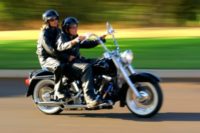Consumer advisory: Motorists should 'Share the Road' with motorcyclists

 To kick off Motorcycle Safety Awareness Month, the U.S. Department of Transportation's National Highway Traffic Safety Administration (NHTSA) is reminding all drivers of cars, trucks and buses to look out for, and share the road with, motorcycle riders. A motorcyclist has the same rights, privileges, and responsibilities as any other motorist on the roadway.
To kick off Motorcycle Safety Awareness Month, the U.S. Department of Transportation's National Highway Traffic Safety Administration (NHTSA) is reminding all drivers of cars, trucks and buses to look out for, and share the road with, motorcycle riders. A motorcyclist has the same rights, privileges, and responsibilities as any other motorist on the roadway.
“Motorcyclists will be out in force as the weather gets warmer, which is why May is the perfect month for Motorcycle Safety Awareness,” said U.S. Transportation Secretary Anthony Foxx. “Fatal crashes with motorcycles are on the rise. We all need to be more aware of motorcyclists in order to save lives and make sure we all ‘Share the Road’. ”
Motorcycle fatalities are up
NHTSA statistics show an increase in motorcycle fatalities in recent years: in 2012, 4,927 motorcyclists were killed in traffic crashes, a continued increase from 2011 (4,630). Those deaths accounted for 15 percent of the total highway fatalities that year, despite motorcycle registrations representing only 3 percent of all vehicles in the United States in 2012. Injured motorcyclists also increased from 81,000 in 2011 to 93,000 in 2012. On a per vehicle mile basis, motorcyclists are more than 26 times more likely to die in a crash than occupants of cars, and five times more likely to be injured.
Helmets could have saved 781 lives in 2012
Helmet usage is also on the decline, dropping from 66 percent of motorcyclists wearing helmets in 2011 to only 60 percent in 2012. Head injury is the leading cause of death in motorcycle crashes. NHTSA estimates that 1,699 lives were saved in 2012 because of proper helmet usage, but another 781lives could have been saved if helmets had been worn. Nineteen states, the District of Columbia, the Northern Mariana Islands, Puerto Rico and the U.S. Virgin Islands have a universal helmet law, requiring helmets for all riders.
“Wearing a helmet on every ride is an important way for a motorcyclist to stay safe, but we all play a part. It’s up to all motorists and motorcyclists to make our roads safer,” said NHTSA Acting Administrator David Friedman. “All road users need to share the responsibility of keeping the roadways safe. By following road signs, obeying speed limits, and always staying focused on the road, deaths could be prevented.”
Cars v. motorcycles: impaired driving
Alcohol continues to be a factor in motorcycle fatalities. The percentage of motorcycle riders who were intoxicated in fatal crashes (27 percent) was greater than the percentage of intoxicated drivers of passenger cars (23 percent) and light trucks (22 percent) in fatal crashes in 2012. Also 29 percent of all fatally injured motorcycle riders had BAC levels of .08 or higher. The problem is especially acute at night. Motorcycle riders killed in traffic crashes at night were over 3 times (3.2) more likely to have BAC levels of .08 or higher than those killed during the day.
To prevent motorcyclist's deaths and injuries, NHTSA offers the following safety tips:
For motorcyclists:
- Wear a DOT-compliant helmet and other protective gear.
- Obey all traffic laws and be properly licensed.
- Never ride distracted or impaired.
- Use hand and turn signals at every lane change or turn.
- Wear brightly colored clothes and reflective tape to increase visibility.
- Ride in the middle of the lane where you will be more visible to drivers.
- Avoid riding in poor weather conditions.
For drivers:
- Allow the motorcycle the full width of a lane at all times.
- Always signal when changing lanes or merging with traffic.
- Check all mirrors and blind spots for motorcycles before changing lanes or merging with traffic, especially at intersections.
- Always allow more follow distance – three to four seconds – when behind a motorcycle. This gives them more time to maneuver or stop in an emergency.
- Never drive distracted or impaired.
- Motorcycle signals are often non-canceling and could have been forgotten. Always ensure that the motorcycle is turning before proceeding.
For more information on motorcycle safety, visit nhtsa.gov/Safety/Motorcycles
Stay connected with NHTSA via: Facebook.com/NHTSA | Twitter.com/NHTSAgov | YouTube.com/USDOTNHTSA | SaferCar.gov
Looking for a reprint of this article?
From high-res PDFs to custom plaques, order your copy today!






